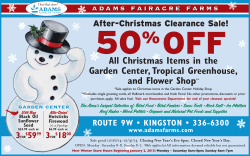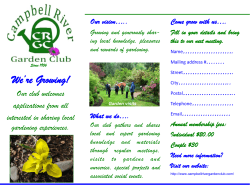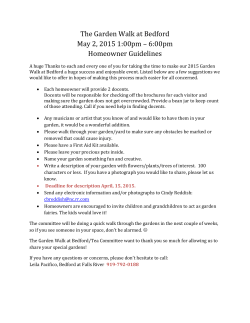
The GSDG - Garden State Daylily Growers
SPRING GSDG S P R I N G The 2015 2 0 1 5 GSDG The Garden State Daylily Growers Newsletter April Meeting President’s Message Even though it doesn’t feel like it, spring has arrived at last! After such a cold and snowy winter, I’m sure we are all looking forward to the upcoming daylily season. Thank you to everyone who attended our March meeting. We welcomed new members, made lots of plans for new and exciting events and shared pictures and stories about our daylilies and gardens. As you begin your spring garden clean up, think about which daylily clumps need to be divided and please donate the extra fans to support our fund raising efforts this summer. Now is the time to make plans to attend one of the many national, regional or GSDG daylily events and join in the fun! Enjoy! - Jane Save the Date! GSDG Picnic May 17, 2015 Falcon Turn Daylily Garden Silent Auction, Plant Swap Daylily Prep Days June 20 & 23, 2015 Daylily Day Falcon Turn Daylily Garden Deep Cut Gardens Prep Plants for Daylily Day Sale June 27, 2015 Bloom Exhibit and Daylily Sale 1 1 The Garden State Daylily Growers will welcome Beth Creveling to our April 12th meeting in the Heath Room at the Red Hill Activity Center in Tatum Park at 151 Red HIll Rd, Middletown, NJ. She will share her knowledge and experience about gardening with daylilies and companion plants. Our luncheon will start at 12:30 PM with the presentation following at 1:30 PM. The meeting will conclude with a 50/50 auction of great garden daylilies from Beth’s collection. Beth’s AHS Display garden, located nearby in Perkasie, Bucks County, PA, holds a vast collection of daylilies, which are incorporated into her garden along with other perennials. She is a board member of the Delaware Valley Daylily Society, a Garden Judge for AHS and has published articles about perennials in the Daylily Journal. What a perfect way to start off the spring gardening season!! SPRING GSDG 2015 Club News Daylily Fans with Extra Daylily Fans!! Donate to a Good Cause! Submitted by Daru Sharp The GSDG is collecting daylily donations for some very good causes; Daylily Day and Rutgers Gardens Open House – both GSDG club fund raisers, and our very exciting new project: The Rutgers Gardens Daylily Demonstration Bed (see article on page 3). We are happy to take whatever daylilies you can contribute either named varieties or seedlings that didn’t make the cut. We have space to store the donated clumps whenever you are ready to dig them from your garden or you can bring them to one of the Daylily Prep Days scheduled prior to the event. We will even make arrangements to have someone come dig and collect the clumps from you if necessary. Please send me information about the daylilies that you would like to donate. My email address is info@daru.com. Helpful information to include in your email: Daylily Name, Hybridizer, and Intro year (if known). If you do not know the name of the daylily or if they are seedlings that you no longer wish to keep, then just include some general information like the color, bloom season, and approximate height. You might also want to tell me why you like this daylily. Include the size of the clump you have to contribute. Small (2-4 fans), Medium (6 – 8 fans), a clump (well, it seems big to you!!). If you happen to have a picture of this daylily in your garden, it would be really great if you could send that along, too. If you don’t like email, you can mail information to me at Daru Sharp, 38 Galloping Brook Rd, Allentown, NJ 08501, or just call: (cell) 732 673 4005 or (home) 609 223 0911. I am looking forward to creating more fans with our fans – (pun intended that time!). Thanks for Your Help And Generosity! Daylily Prep Days at Falcon Turn Daylily Garden In order to help collect and prepare daylily donations for our fund raising events, we have scheduled several Daylily Prep Days. We will work together as a group to dig, split and label donated daylilies for each fund raising event. Hopefully this will help increase the amount of plants we will have to offer for sale! Workers will get a free daylily and the opportunity to shop from the donated assortment at discounted prices. Daylily Prep Days for Daylily Day - Saturday, June 20 & Tuesday, June 23, 2015 -10:00 to 2:00 Daylily Prep Days for Rutgers Open Garden - Sunday, July 19 & Tuesday, July 21, 2015 – 10:00 – 2:00. 2 2 2 1 SPRING GSDG 2015 Garden State Daylily Growers Demonstration Bed at Rutgers Gardens Submitted by Peter McIntyre The GSDG Daylily Demonstration Garden at Rutgers Gardens is moving along. We have been provided a bed along the vegetable garden fence in Rutgers Garden that might be 180 feet or so. This year we will start with the first 60 feet and we will make the bed 3 feet wide. The purpose of this daylily demonstration garden is three fold: to educate the public about the wonderful world of the daylily, to show off talented New Jersey hybridizers, and to provide a beautiful display of daylilies that will bloom from the very early bloom season to the very late. At this time, we are going to work on the first 60 feet in this garden. It is always better to start slow, and work out the kinks in the project. We are looking, for this first year, to put in 60 different varieties of daylilies. We are asking for donations from or of NJ hybridizers, as well as donations of plants that are extra early and very late. We will then fill in the rest of the season with beautiful examples of these wonderful plants. Bruce Crawford, the Director of Rutgers Gardens, has made it very clear that the plants we use are entirely up to us as a group. He will accept our designs, and plant selections for the garden with no restrictions. If certain plants do not really belong, we are free to remove them or substitute. Rutgers will kill the grass, prep the location, have it ready for us after mid May and provide the maintenance to keep the bed beautiful throughout the growing season. This Daylily Demonstration Garden will be our design, today and in future. 3 3 SPRING GSDG 2015 It’s Hummingbird Time! Submitted by Lester Block There is only one species of hummingbird that breeds in New Jersey, the Ruby-throated Hummingbird. Relatively common throughout New Jersey from spring through late summer, they are among the smallest of migrating birds (3.5” from tip of beak to tip of tail), traveling every year from their winter homes in Mexico and Central America. Their journey takes them 525 miles, across the Gulf of Mexico, in 20 hours non-stop, to the United States and Canada. A total distance over 2,500 miles! An incredible feat for a bird that generally weighs less than a nickel. The males arrive before the females and stake out their territories in April. It is a good idea to have your feeders in place by April 15th. A good way to remember this is to have them out by tax day. It is easy to entice these gems to frequent your yard and gardens. You must first buy a hummingbird feeder. These are relatively inexpensive and can be found in the large, box stores, hardware and feed supply stores, garden centers and online. Look for feeders that have some red on them. The red will attract the bird’s attention and help draw it to the feeder. Also, it is wise to purchase one with bee guards over the feeding stations and an ant trap. Once you find one you like, look it over. Does it seem overly ornate? Does it have openings large enough to get a bottle brush into? These are important considerations because the feeder will need to be cleaned frequently, especially during hot weather. What do hummingbirds eat? In nature, their diet consists primarily of energy rich food sources such as flower nectar and small insects. These tiny birds burn a lot of energy and must eat their weight in food daily. A hummingbird feeder serves as a supplement to any natural food sources. They are not really vital to the survival of the birds with the possible exceptions of times of bad weather or a very late, or very early cold 4 4 2 1 SPRING GSDG 2015 It’s Humming Bird Time (cont. from page 4) snap that kills the flowers and insects. In these instances, a clean, filled feeder can make a difference in the bird’s survival. feeder will hasten fermentation of the sugar/water solution and the feeder will have to be cleaned more frequently. Finally, the feeders need to be where you can see and enjoy them. Easy access will allow for easy filling and cleaning during the season. Once the birds become accustomed to your feeders, you can move them to almost any position and enjoy the birds. Hummingbirds remember a reliable food source. They have been known to return to the same spot, year after year, even if the feeder hasn’t been hung yet. Take your newly purchased feeder and wash it out with hot, soapy water. Then rinse it clean. It is now ready to fill with hummingbird food. What will you feed the hummingbirds? At the beginning of the season, the birds will be looking for nectar sources. Where do you buy nectar? You can find it in many of the same places that sell hummingbird feeders. Avoid the nectar mixes that are artificially colored red. Keep the feeders clean and full. When temperatures are about 75 degrees F, you can clean them every 2 or three days. Much hotter than that, it becomes necessary to clean them daily. Use warm soapy water and a bottle brush. Sometimes a 10% bleach and water solution is helpful. White vinegar (undiluted) is sometimes used instead of bleach. The red coloring on your feeder should be enough to attract the birds. If your feeder is lacking red colors, just add some yourself with some red paint, nail polish or decals. You can save yourself some money by making your own “nectar” by mixing four parts of water with one part of white, table sugar. Boil it for about two minutes to dissolve it, and store it in the refrigerator until needed. This mixture is a replication of the natural sugar in flowers, is easy to digest, nutritious and provides the birds with energy and calories. There are supplements available that add extra protein and vitamins but, it has been my experience that the hummingbirds generally avoid these mixtures. As gardeners, we can all plant nectar rich flowers to attract hummers. Salvia coccinea is particularly attractive as are some of the blue salvias. Agastache, honeysuckles, columbine, morning glory, four o’clocks, trumpet vine, cardinal vine, fuchsia, impatiens, kniphopia, lobelia, bee balm, monarda, horse mint, penstemons…almost any tubular flower. I’ve even seen hummers feed on cannas and petunias. Unfortunately, for us daylily growers, the daylily flowers do not provide enough nectar to entice hummingbirds. If you see them feeding around your daylily beds, they are most likely gleaning small insects. The feeders need to be located where the birds can easily find them. Try tying a piece of red or orange ribbon or tape to the tree or branch you are hanging your feeder from. This provides a long distance visual cue to migrating hummingbirds and they will come in for a closer look. If you have some flowering plants, try placing it nearby. Avoid locations that are in direct sunlight. The sun beating down on the Now sit back and enjoy your hummingbirds. Lester Block 5 5 GSDG SPRING 2015 New Members Martin Barry – A member of AHS and interested in collecting daylilies. Curtis Cerillo – Is interested in collecting, hybridizing and organic gardening with daylilies. Bud builders, spiders and unusual forms are favorites. John Hamilton – Hybridizing and gardening daylilies with tall, strong scapes and rapid increase. Yellows with bold eyes and edges are favorites. Susan Kauffman – Loves all daylily forms in her garden. Favorite colors include peach, yellows and reds. Donna Mottola – Enjoys gardening with pastel daylilies. Welcome! Adria Narke – Loves all forms of purple, yellow and red daylilies. She wants to learn more about hybridizing for fun. Mary Lou Newborg – Garden includes all forms of daylilies. Loves the yellows! Charlotte Pritchard – Interested in hybridizing, collecting and gardening with doubles and unusual forms as favorites. Mary Lou Rossi – Gardens and collects daylilies with bold bright eyes, tall scapes and high bud count. Joseph Rossi – Likes all forms of daylilies especially ones with teeth, ruffles, rebloom and high bud count. White, pink and orange are his favorites. Photo Credits – All photos by Jane Guillard unless otherwise noted Pg. 1 top left – provided by Daru Sharp, bottom right – provided by Beth Creveling, Pg. 2 top left – provided by Curtis Cerillo, bottom right – provided by Lynn Hopkins, Pg. 3 bottom left- provided by Richard Haynes, Pg.6 – Provided by Melissa Rozecki President: Jane Guillard - 609-330-2933 - falconturndaylilies@comcast.net Board Members Vice-President: John Monschauer – 973-764-6048 – monsch63@gmail.com Treasurer: Patricia Scarano – 732-257-6246 – psacarano2@aol.com Secretary: Mary Pabst – 732-270-5878 – Ctulip@verizon.net Daylily Day Coordinator: Mary Lovasz – 732-787-2794 – Melovasz1@verizon.net Additional Board Members: Mike Oliver, Rosemary Staba Webmaster: Terry McGarty GSDG Website – www.gsdaylily.net 6
© Copyright 2025









